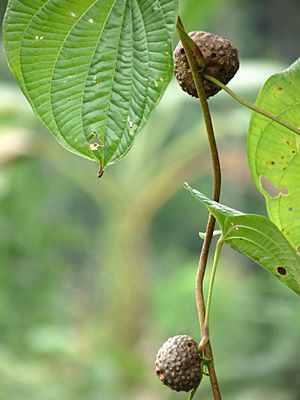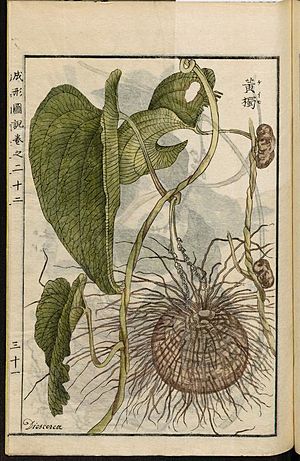Dioscorea bulbifera facts for kids
Quick facts for kids Air potato |
|
|---|---|
 |
|
| Scientific classification | |
| Genus: |
Dioscorea
|
| Species: |
bulbifera
|
| Synonyms | |
|
|
The Air potato (scientific name: Dioscorea bulbifera) is a type of yam plant. It is also known as the air yam, bitter yam, or potato yam. This plant originally comes from Africa, Asia, and northern Australia. It is now grown in many places and has spread to new areas. These include Latin America, the West Indies, the southeastern United States, and various islands.
In Nigerian Pidgin English, people sometimes call it the up-yam. This is because the plant grows special potato-like parts above the ground. These parts are called bulbils.
Contents
What is the Air Potato?
The Air potato is a perennial vine. This means it lives for more than two years. It has wide leaves that grow in an alternating pattern along its stem. The plant creates two kinds of storage parts. It grows bulbils (like small potatoes) in the leaf corners of its climbing stems. It also forms tubers underground, similar to regular potatoes.
Some types of Air potato can be eaten. People grow them as a food crop, especially in West Africa. The tubers of these edible types can taste bitter. However, boiling them can remove this bitter taste. After boiling, you can prepare them like other yams, potatoes, or sweet potatoes.
How Fast Does it Grow?
The Air potato can grow incredibly fast, about 8 inches (20 cm) every day! It can reach over 60 feet (18 meters) long. It often climbs to the tops of trees. This plant tends to take over and cover native plants.
New Air potato plants grow from the bulbils that form on the vine. These bulbils help the plant spread to new places. The parts of the plant above ground die back in winter. But new shoots grow from the bulbils and underground tubers when spring arrives. The main way this plant spreads is through its bulbils. Even very small bulbils can sprout, making the plant hard to control. The vine also produces small white flowers, but these are rarely seen in places like Florida. The fruits are small capsules.
Uses of Air Potato
People have used the Air potato as a folk remedy for a long time. It has been used to help with problems like eye irritation (conjunctivitis), diarrhoea, and dysentery.
The D. bulbifera plant is very important to the Tiwi people in Australia. They use it in a special ceremony called kulama. During this ceremony, the tubers are cooked in a traditional way. They are then eaten on the third day of the ceremony.
Is it Poisonous?
Some types of Air potato, especially those growing wild, can be poisonous. For example, the wild plants found in Florida can be harmful. These types contain a substance called diosgenin. This substance is used to make certain medicines.
There have been stories that even the wild, poisonous types can be made safe to eat. This is said to happen after drying and boiling them. This has caused some confusion about how truly poisonous the plant is. It is always best to be careful with wild plants.
Why is it an Invasive Species?
In some areas, like Florida, the Air potato is considered a noxious weed. This means it is a harmful plant. It grows very quickly and has large leaves. The vine spreads aggressively and blocks sunlight from other plants growing underneath it.
The bulbils on the vines sprout and become new vines. These new vines twist around each other, forming a thick mat. If the plant is cut down, the underground tubers can survive for a long time. They can then send up new shoots later.
Scientists have studied a special leaf beetle called Lilioceris cheni. This beetle is used to help control the Air potato plant. It was released in 2012 as a way of biological pest control. This means using one living thing to control another, harmful living thing.


